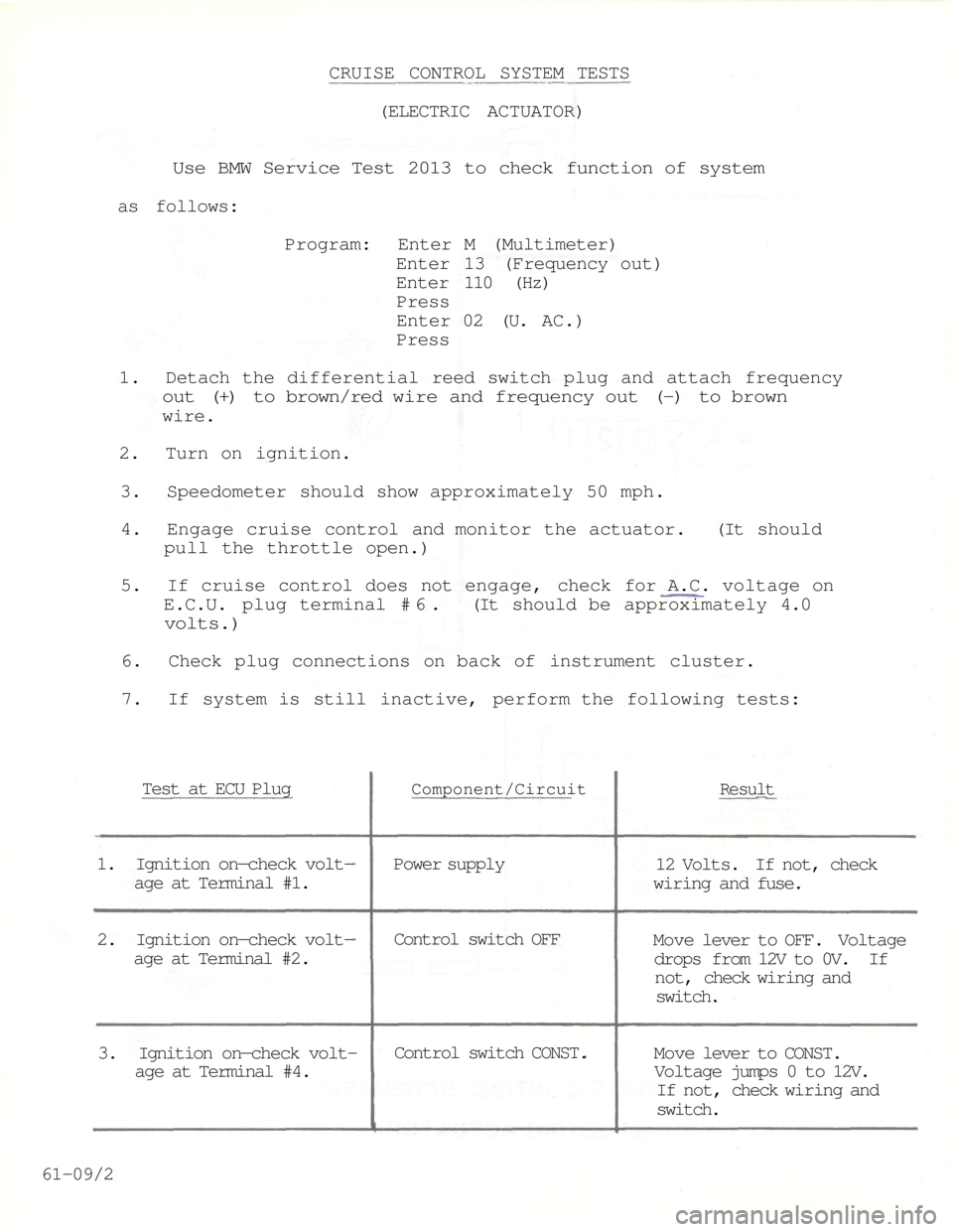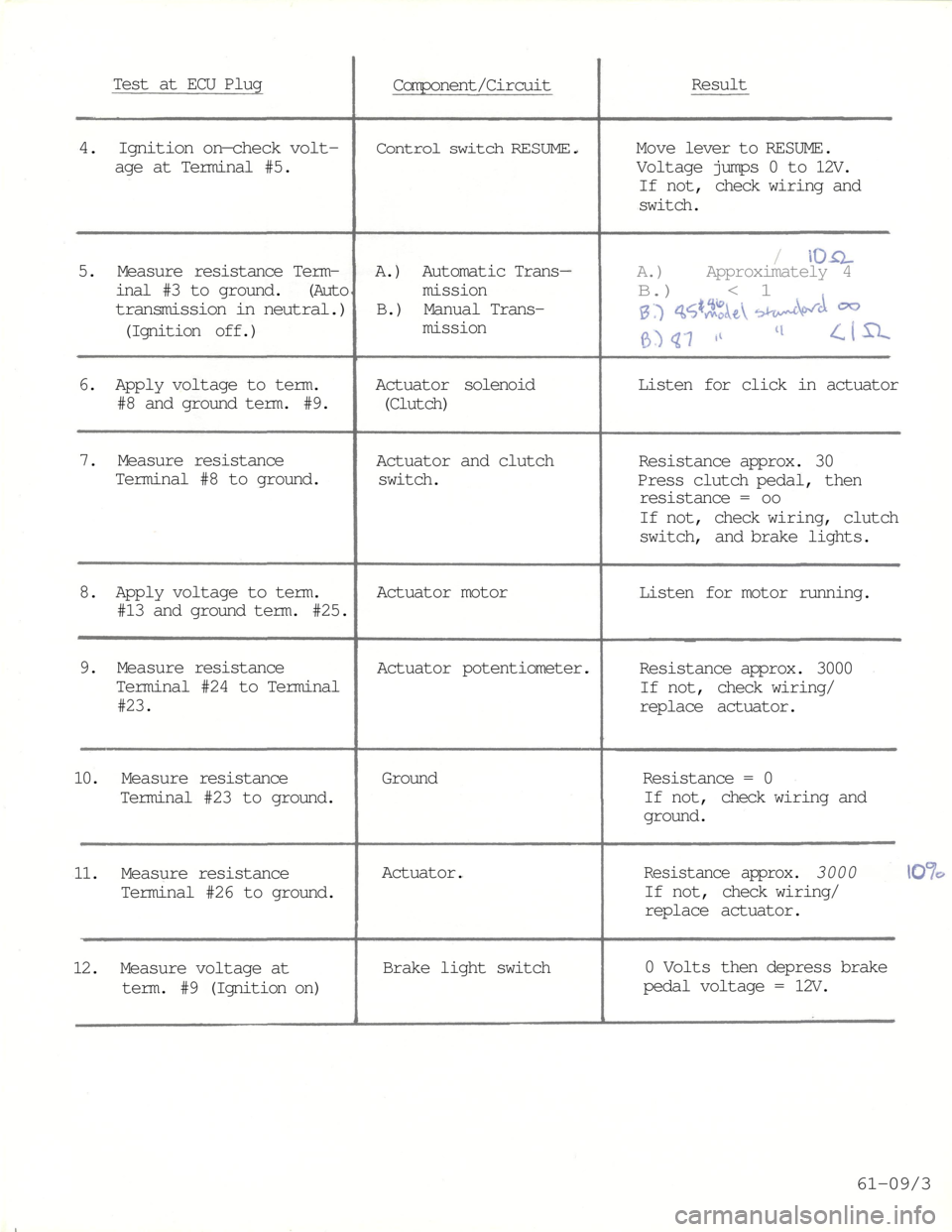Page 1 of 14
CRUISE CONTROL WITH ELECTRIC ACTUATOR
Group 61 - Chassis Electrics
Produced By:
BMW of North America, Inc
Issued 7/83
61-09
Page 2 of 14

CRUISE CONTROL WITH ELECTRIC ACTUATOR
The electric actuator type cruise control system was intro-
duced on the BMW 733i and 528e models in 1982. From 1983 all
six-cylinder models will use this type.
The system is designed to operate at between 20 and approximately
90 mph. An electronic control unit (E.C.U.) controls an
electric actuator which maintains the desired road speed via
the throttle linkage.
Driver control is through a three-function switch operated by
a lever mounted on the right side of the steering column be-
hind the wiper lever.
Pushing the lever forward in the CONST position engages the
system and the car will accelerate until the lever is re-
leased. The E.C.U. contains a memory circuit which will hold
the speed that exists when the lever is released from the
CONST. position. Momentary operation of the lever in the CONST.
position will also cause engagement and lock the prevailing
speed into the memory.
Cruise control may be disengaged in any of five different
ways; momentarily moving the control switch up or down to OFF,
applying the foot brake, shifting the automatic transmission to
neutral, depressing the clutch, or whenever the actual speed
drops more than 15 mph below the memory speed.
Following disengagement, the car can be returned to the pre-
viously selected speed by pulling the control lever to RESUME.
The memory circuits in the E.C.U. are reset whenever the
lever is moved to CONST, but the only time the memory is cleared
is when ignition is turned off.
The E.C.U. receives a processed signal from the electronic
speedometer, which is equivalent to actual road speed. Con-
sequently, speedometer problems will affect cruise control.
Page 3 of 14
ACTUATOR
CLUTCH SWITCH
BRAKE SWITCH
CRUISE CONTROL SCHEMATIC
(ELECTRIC ACTUATOR)
OFF
61-09/1
CABLE
GAS LINKAGE
BRIDGE
(AUTOMATIC)
ECU
SPEEDO
OFF
REED SWITCH
RESUME
CONST.
R
N
D
2
1
P
Page 4 of 14

CRUISE CONTROL SYSTEM TESTS
(ELECTRIC ACTUATOR)
Use BMW Service Test 2013 to check function of system
as follows:
Program: Enter M (Multimeter)
Enter 13 (Frequency out)
Enter 110 (Hz)
Press
Enter 02 (U. AC.)
Press
1. Detach the differential reed switch plug and attach frequency
out (+) to brown/red wire and frequency out (-) to brown
wire.
2. Turn on ignition.
3. Speedometer should show approximately 50 mph.
4. Engage cruise control and monitor the actuator. (It should
pull the throttle open.)
5. If cruise control does not engage, check for A.C. voltage on
E.C.U. plug terminal #6. (It should be approximately 4.0
volts.)
6. Check plug connections on back of instrument cluster.
7. If system is still inactive, perform the following tests:
Test at ECU Plug
Component/Circuit
Result
1. Ignition on—check volt-
age at Terminal #1.
Power supply
12 Volts. If not, check
wiring and fuse.
2. Ignition on—check volt-
age at Terminal #2.
Control switch OFF
Move lever to OFF. Voltage
drops from 12V to 0V. If
not, check wiring and
switch.
3. Ignition on—check volt-
age at Terminal #4.
Control switch CONST.
Move lever to CONST.
Voltage jumps 0 to 12V.
If not, check wiring and
switch.
61-09/2
Page 5 of 14

Test at ECU Plug
Component/Circuit
Result
4. Ignition on—check volt-
age at Terminal #5.
Control switch RESUME.
Move lever to RESUME.
Voltage jumps 0 to 12V.
If not, check wiring and
switch.
5. Measure resistance Term-
inal #3 to ground. (Auto
transmission in neutral.)
(Ignition off.)
A.) Automatic Trans-
mission
B.) Manual Trans-
mission
A.) Approximately 4
B.) < 1
6. Apply voltage to term.
#8 and ground term. #9.
Actuator solenoid
(Clutch)
Listen for click in actuator
7. Measure resistance
Terminal #8 to ground.
Actuator and clutch
switch.
Resistance approx. 30
Press clutch pedal, then
resistance = oo
If not, check wiring, clutch
switch, and brake lights.
8. Apply voltage to term.
#13 and ground term. #25.
Actuator motor
Listen for motor running.
9. Measure resistance
Terminal #24 to Terminal
#23.
Actuator potentiometer.
Resistance approx. 3000
If not, check wiring/
replace actuator.
10. Measure resistance
Terminal #23 to ground.
Ground
Resistance = 0
If not, check wiring and
ground.
11. Measure resistance
Terminal #26 to ground.
Actuator.
Resistance approx. 3000
If not, check wiring/
replace actuator.
12. Measure voltage at
term. #9 (Ignition on)
Brake light switch
0 Volts then depress brake
pedal voltage = 12V.
61-09/3
Page 6 of 14

FOR CRUISE CONTROL TO BE ENGAGED
PIN 9 MUST SENSE GROUND THROUGH
STOPLIGHTS.
WHEN BRAKE SWITCH IS CLOSED OR
CLUTCH SWITCH IS OPEN, GROUND IS
ELECTRONICALLY REMOVED.
CRUISE CONTROL ELECTRICAL SCHEMATIC
BRAKE
SWITCH
CLOSED WITH BRAKE
PEDAL DEPRESSED
POWER
DISTRIBUTION
BOX
CLUTCH
SWITCH
OPENS WHEN
CLUTCH PEDAL
IS DEPRESSED
POWER
DISTRIBUTION
BOX
AUTOMATIC
TRANSMISSION
RANGE SWITCH
AUTOMATIC TRANSMISSION
CRUISE
CONTROL
SWITCH
C210
CRUISE CONTROL
CONTROL UNIT
TRANSMISSION
RANGE
DISPLAY
TO THROTTLE
VALVE
FEEDBACK
POTENTIOMETER
INSTRUMENT
CLUSTER
CRUISE
CONTROL
ACTUATOR
CLUTCH
SOLENOID
CANCEL RESUME ACCELERATE/
SPEED SET SPEED
CONTROL INPUTS
INSTRUMENT
CLUSTER
MANUAL
TRANSMISSION
IDLE
SPEED
CONTROL
FUSE 6
8 AMP
POWER
DISTRIBUTION
POWER
DISTRIBUTION
ACCELERATE/
SET
OFF RESUME
OFF
S217 C206 S309 C301
.75 GN/WT
.5 VI/WT C210 GN/WT
CLUTCH CONTROL CONTROL MOTOR CRUISE
OUTPUT OUTPUT ENABLE
SEE DASH LIGHTS
GROUND
"N"
OUTPUT
BAND
1.5 GN/WT
1 GN/WT
11
1 GN/WT
.75 GN/WT
.75 GN/WT
1
.75 8U/3R
.75 BU/BR
S234
3
15
1
2
D
6
N
R
P
S
W
0
GN
BU
.5 YL
.5 GN
.5 BU
4
5
SPEEDOMETER
SOLID STATE
2
C8
.5 BU/YL
CRUISE CONTROL
CONTROL UNIT
POWER INPUT
.5 VI/WT
C250
STOP LIGHTS
.5 GN/RD
.5 GN/RD
MANUAL
TRANSMISSION
AUTOMATIC
TRANSMISSION
C208
.5 GN/RD
C208
61-09/5
S224
.5 GN/RD
.5 GN/RD
9
G200
.5 BR
SPEEDOMETER
.5 VI/WT
1.5 VI/WT
S241
FUSE 12
8 AMP
.5 VI/WT
VEHICLE SPEED
INPUT
CRUISE
ENABLE
.75
BU/BR
C8
GROUND
FEEDBACK
REFERENCE
FEEDBACK
INPUT
SOLID STATE
24
26
.5 GY/RD
.5 GN/YL
4
.5 RD
7
.5 YL
.5 BR
3
S233
(-)
12
16
C1
C6
.5 BR
.5 BR
G200
.5 BR
.75 BU/BR
6
7
.75 BU/BR
.5 BU
C209
.5 BU/WT
2
3
G200
13
.5 BK
5
.5 BK
.5 GN
.5 WT
.5 WT
CONTROL
MOTOR
1
Page 7 of 14
CRUISE CONTROL WITH VACUUM SERVO
Group 61 - Chassis Electrics
Produced by
BMW OF NORTH AMERICA, INC.
Revised 7/83
61-08
Page 8 of 14

CRUISE CONTROL
The BMW cruise control is designed to operate between 20
and approximately 90 mph. An electronic control unit (E.C.U.)
controls a vacuum operated servo unit which actuates the
throttle linkage to maintain the required road speed.
Drive control is through a three function switch operated
by a lever mounted on the right side of the steering column
behind the wiper lever.
Pushing the lever forward in the CONST position engages the
system and the car will accelerate until the lever is
released. The E.C.U. contains a memory circuit which will
hold the speed that exists when the lever is released from
the CONST position. Momentary operation of the lever in the
CONST position will also cause engagement and lock the
prevailing speed into the memory.
Cruise control may be disengaged in any of five different
ways: momentarily moving the control switch up or down to
OFF, applying the foot brake, shifting the transmission to
neutral, or whenever the actual speed drops more than 7 mph
below the memory speed.
Following disengagement, the car can be returned to the
previously selected speed by pulling the control lever to
RESUME.
The memory circuits in the E.C.U. are reset whenever the
lever is moved to CONST but the only time the memory is
cleared is when ignition is turned off.